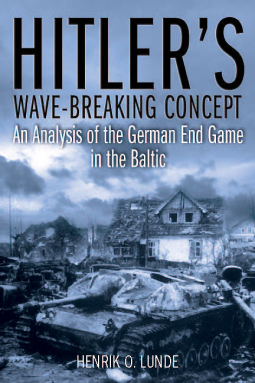
HITLER'S WAVE-BREAKING CONCEPT
An Analysis of the German ENd Game in the Batlic
by Henrik O Lunde
This title was previously available on NetGalley and is now archived.
Send NetGalley books directly to your Kindle or Kindle app
1
To read on a Kindle or Kindle app, please add kindle@netgalley.com as an approved email address to receive files in your Amazon account. Click here for step-by-step instructions.
2
Also find your Kindle email address within your Amazon account, and enter it here.
Pub Date Mar 25 2013 | Archive Date Apr 26 2013
Description
Among the many controversies of World War II, prominent is the
debate over Germany’s strategy in the north of the Soviet Union, as the tide of
war turned, and gigantic Russian armies began to close in on Berlin. In this
long-awaited work, Henrik Lunde—former U.S. Special Forces officer and author of
renowned previous works on the campaigns in Norway and Finland—turns his sights
to the withdrawal of Army Group North.
Providing cool-headed analysis to
the problem, the author first acknowledges that Hitler—often accused of holding
onto ground for the sake of it—had valid reasons in this instance to maintain
control of the Baltic coast. Without it, his supply of iron ore from Sweden
would have been cut off, German naval (U-boat) bases would have been
compromised, and an entire simpatico area of Europe—including East Prussia—would
have been forsaken. On the other hand, Germany’s maintaining control of the
Baltic would have meant convenient supply for forces on the coast—or evacuation
if necessary—and perhaps most important, remaining German defensive pockets
behind the Soviets’ main drive to Europe would tie down disproportionate
offensive forces. Stalwart German forces remaining on the coast and on their
flank could break the Soviet tidal wave.
However, unlike during today’s
military planning, the German high command, in a situation that changed by the
month, had to make quick decisions and gamble, with the fate of hundreds of
thousands of troops and the entire nation at stake on quickly decided throws of
their dice.
As Henrik Lunde carefully details in this work, Hitler
guessed wrong. By leaving four entire battle-hardened armies in isolation along
the Baltic, the Soviets pulling up to the Oder River encountered weaker
opposition than they had a right to expect. Having economic (or aid) resources
of their own, they cared little for Hitler’s own supply line and instead simply
lunged at his center of power: Berlin. Once that was taken the remaining German
pockets could be wiped out. The Germans deprived themselves of many of their
strongest forces when they most needed them, and the climactic battle for their
capital took place.
In this book, both combats and strategy are
described in the final stages of the fighting in the Northern Theater, with
Lunde’s even-handed analysis of the campaign a reward to every student of World
War II.
Marketing Plan
• Trade, library and direct-audience review mailing to local, regional and national
publications
• Catalog and website advertising
• Direct-mail and internet promotion
• Simultaneous launches in the US and UK
• Sales presentations to all major chain stores, select local bookstores, national catalog
booksellers and book clubs
Available Editions
| EDITION | Hardcover |
| ISBN | 9781612001616 |
| PRICE | $32.95 (USD) |



